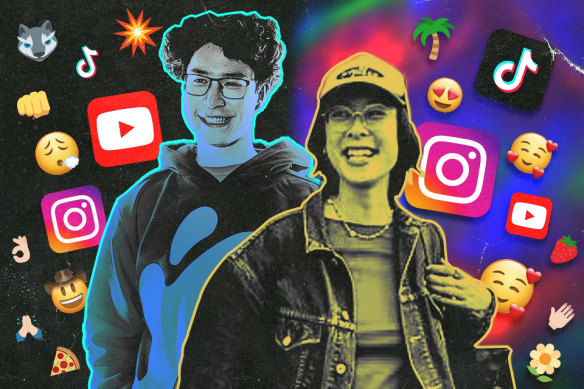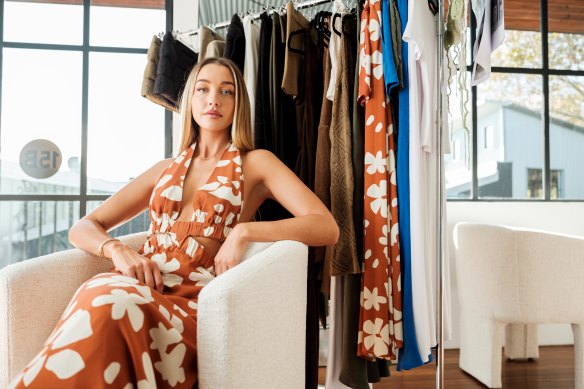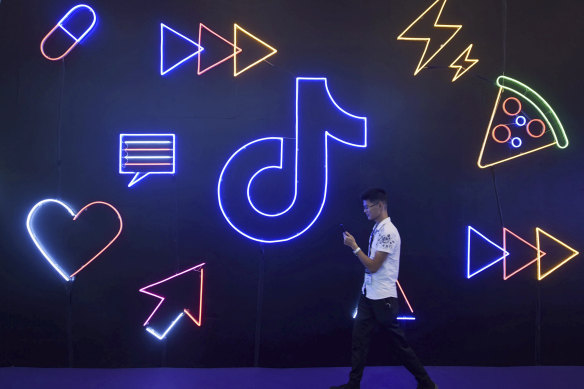- Business
- Entrepreneurship
- Social media
This was published 5 months ago
$10,000 for making one video? Maybe it’s time to switch careers
By Kayla Olaya
Australian content creator Jordan Barclay started posting Minecraft gaming videos to YouTube at age 10. A decade later, he launched a media production company that is this year forecast to rake in $10 million.
But Barclay, 22, who is known as EYstreem to almost 11 million YouTube subscribers, says there are not enough gaming content creators in Australia, and that the country is losing out on a slice of a multibillion-dollar industry.

Content creators Jordan Barclay (left) and Maggie Zhou. Marketing budgets for influencer companies are expanding as the industry booms.Credit: Aresna Villanueva
“There are infinite amounts of money out there outside of gaming, from gaming, which is why it is a really sustainable [industry]. But also, being a YouTuber isn’t the only way you can work in the creator economy,” he says.
Barclay’s company, Spawnpoint Media, hires promising 17-year-olds starting out on six-figure salaries and trains them in writing, producing, post-production, filming, editing and animating to name a few roles, to fulfil a shortage of those jobs in Australia. Barclay finds himself flying to the US just to secure gaming-specific talent that doesn’t exist locally.
“I know from every creator who is playing at the level that we are, that they are desperately trying to find hires because nobody understands that these roles exist,” he says.
“We’ve got salaries up to high six figures, and with bonuses up to seven [figures] – there is so much money in this industry. We mean business, and I don’t think that we’ll be going away anytime soon.”
Let’s get nosy: How much are these content creators making?
Influencing or content creation may have been thought of as a fad career choice just a few years ago, but companies have never been so keen to expand their marketing budgets to put funding towards influencer marketing.
The share of brands increasing their marketing budget for influencers has grown by 67 per cent, says data gathering company Statista. In 2024, advertising spending on influencer marketing in Australia is projected to hit $800 million, with an annual growth rate of almost 12 per cent and a projected market value of $1.39 billion by 2029.
Globally, the influencer marketing sector is projected to grow 13.7 per cent to $US19.8 billion in 2024, with the global creator economy estimated to grow from $US127.65 billion in 2023 to $US528.39 billion in 2030, with a 22.5 per cent compound annual growth rate.
For one post, an influencer with 500,000 or more followers can earn up to $15,000 to $30,000 for a campaign, says a spokesperson for Fabulate, an Australian tech platform that connects creators and influencers with branded marketing campaigns. The tech group says it has worked on campaigns with influencers within a payment range of $100 to $200,000.
“The biggest creators in Australia [can] leverage their social following into other work, be that media e-commerce or other revenue streams,” a Fabulate spokesperson says.
“The best creators though become businesses in their own right. The most famous example of that globally is obviously Mr Beast, but here locally in Australia, there’s plenty of creators who have made this leap as well. The Inspired Unemployed, Brittney Saunders, Sammy Robinson, Tash Oakley – there are hundreds of these types of creators who like to transfer that influence that they’ve gained into other business ventures.”
Dr Natalya Saldanha, who researches social media influencers for Victoria University, says the social media content creator industry is expanding, and that the numbers point to it only heading upwards.

Sammy Robinson is one of Australia’s most prominent content creators.Credit: Oscar Colman
“Consumers are actually seeking authenticity from influences they follow, and they prioritise relatable and original content, with 61 per cent of consumers wanting to follow relatable personalities, compared to 43 per cent of expert personalities,” she says.
Saldanha says that influencer marketing is expected to reach about $US24 billion ($34.9 billion) by the end of the year, and nearly 85 per cent of brands are tracking sales from influencer marketing campaigns alone.
Why are brands throwing so much money at content creation?
A 2023 industry study found 81 per cent of consumers had either purchased, researched or considered purchasing a product after seeing influencers post about it, and 69 per cent of respondents were likely to trust an influencer’s recommendations over those coming from brands.
Brands are waking up to the impact content creators have on their audiences and the authentic relationship they build with them, says Patrick Whitnall, the managing director of Australian Influencer Marketing Council.
“You have to look at the back end of the multitude of skills that creators and influencers have. These are people that are able to edit, create content, they understand the social media platforms and how to connect with audiences, and they’re very, very creative,” he says.
“A lot of brands are looking for that within their businesses. Not just in this market, but other markets where they hire influencers or creators to come on and run their … social media channels for them.”
For some successful content creators, the leap to full-time content creation was something of a sacrifice.
Popular TikToker and podcaster Maggie Zhou has recently taken the plunge towards taking on content creating full-time since gaining fame on social media after a decade. She says that once she began making six figures off influencing alone she felt comfortable going all in.
Zhou, who has amassed 18,000 followers on TikTok and 51,500 on Instagram, is a freelance culture writer and the podcast co-host of Culture Club, which she has been producing with co-host Jasmine Wallice since 2020.
Investing in influencer marketing can be a very strategic move, Zhou says, as “you’re getting a production company and a marketing agency, all wrapped up in one. Influencers do work independently as well, so they are the ones conceptualising, filming, editing, and posting.”
Despite the bags of money content creation can yield, Zhou says there are still negative connotations around the influencer career choice. Women hold a 70 per cent market share of the industry, a 2024 influencer marketing report found.

Influencer marketing budgets have soared, and the industry is projected grow to over $1 billion by 2026. Credit: AP
“When we think of influencing as a social construct, it’s very women dominated. It’s frowned upon [and] it’s not taken that seriously, and I don’t think that should be the case,” Zhou says.
Eighteen million Australians use social media, and of the time Australians spend online, one in every three minutes is spent on social media, according to Prosperity Media.
YouTube is the second-most popular social media platform, behind only Facebook, with 15 million active Australian users a month, but generates much more revenue for its content creators.
Barclay, the Minecraft gamer, says Australia is a good 10 years behind other international gaming economies.
“Most people don’t realise these jobs exist, and they don’t realise that this is a multibillion-dollar industry, which is quite funny because Australia has the most people subscribed to over a million views than any other country in the world,” he says.
“And yet, for me to do any of my work functions, to build networks and to hire, I’m constantly flying over to the States to do that because nobody is doing this here in Australia. It’s an incredibly untapped market.”
The Business Briefing newsletter delivers major stories, exclusive coverage and expert opinion. Sign up to get it every weekday morning.